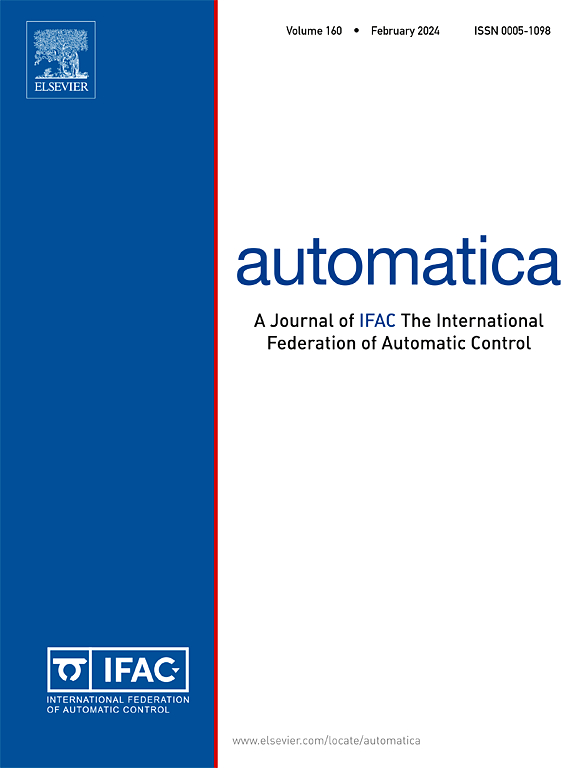在规定时间内对不平衡有向图进行完全分布式资源分配:一种宽松的时基生成器方法
IF 5.9
2区 计算机科学
Q1 AUTOMATION & CONTROL SYSTEMS
引用次数: 0
摘要
本文重点讨论了在现实场景中设计分布式优化算法的三个关键方面:可行性、收敛时间和对不平衡网络的适用性。考虑到这些挑战,可以解决一类特定的资源分配问题(rap)。这些rap发生在不平衡的有向图上,有严格的时间限制,并且需要持续的资源需求平衡。为了解决这些挑战,提出了一个宽松的时基生成器框架。然后,导出了保证TBGs达到规定时间收敛的充分条件。其次,利用所设计的TBGs,首先开发了一种新的适用于非平衡有向图上的RAPs的规定时间分布连续时间优化算法。该算法擅长于在用户定义和任意时间范围内解决这些问题。第三,提出了上述规定时间优化算法的全分布式设计,消除了严格的全局拓扑知识。正式证明了两种算法都能在规定的收敛时间内实现最优的资源分配。此外,这两种算法通过在整个操作过程中保持资源需求平衡来确保持续的可行性,并且与现有的原始对偶方法及其变体相比,在简单性方面具有显着优势。所提出的算法在设计过程中不需要拉格朗日乘子,从而更直接方便地处理耦合资源需求约束。最后,通过数值仿真验证了所提算法的有效性。本文章由计算机程序翻译,如有差异,请以英文原文为准。
Fully distributed resource allocation over unbalanced digraphs in prescribed time: A relaxed time-base generator approach
This paper focuses on three critical aspects of designing distributed optimization algorithms in real-world scenarios: feasibility, convergence time, and applicability to unbalanced networks. A specific class of resource allocation problems (RAPs) are addressed with these challenges in mind. These RAPs occur over unbalanced digraphs, have strict time constraints, and require continuous resource-demand balance. To tackle these challenges, a relaxed framework of time-base generators (TBGs) is presented. Sufficient conditions are then derived to guarantee that TBGs achieve prescribed-time convergence for distributed optimization. Secondly, leveraging the designed TBGs, a new prescribed-time distributed continuous-time optimization algorithm specifically suited for RAPs over unbalanced digraphs is firstly developed. This algorithm excels at solving these problems within user-defined and arbitrary timeframes. Thirdly, a fully distributed design of the above prescribed-time optimization algorithm is put forward to eliminate the stringent global topology knowledge. It is formally proved that both algorithms achieve the optimal resource allocation within prescribed-time convergence. Furthermore, both algorithms ensure continuous feasibility by maintaining resource-demand balance throughout operation and offer a significant advantage in simplicity compared to existing primal–dual methods and their variants. The proposed algorithms exclude the need for Lagrangian multipliers in the design process, leading to a more straightforward and convenient approach to handling the coupled resource-demand constraint. Finally, the effectiveness of the proposed algorithms is substantiated through numerical simulations.
求助全文
通过发布文献求助,成功后即可免费获取论文全文。
去求助
来源期刊

Automatica
工程技术-工程:电子与电气
CiteScore
10.70
自引率
7.80%
发文量
617
审稿时长
5 months
期刊介绍:
Automatica is a leading archival publication in the field of systems and control. The field encompasses today a broad set of areas and topics, and is thriving not only within itself but also in terms of its impact on other fields, such as communications, computers, biology, energy and economics. Since its inception in 1963, Automatica has kept abreast with the evolution of the field over the years, and has emerged as a leading publication driving the trends in the field.
After being founded in 1963, Automatica became a journal of the International Federation of Automatic Control (IFAC) in 1969. It features a characteristic blend of theoretical and applied papers of archival, lasting value, reporting cutting edge research results by authors across the globe. It features articles in distinct categories, including regular, brief and survey papers, technical communiqués, correspondence items, as well as reviews on published books of interest to the readership. It occasionally publishes special issues on emerging new topics or established mature topics of interest to a broad audience.
Automatica solicits original high-quality contributions in all the categories listed above, and in all areas of systems and control interpreted in a broad sense and evolving constantly. They may be submitted directly to a subject editor or to the Editor-in-Chief if not sure about the subject area. Editorial procedures in place assure careful, fair, and prompt handling of all submitted articles. Accepted papers appear in the journal in the shortest time feasible given production time constraints.
 求助内容:
求助内容: 应助结果提醒方式:
应助结果提醒方式:


